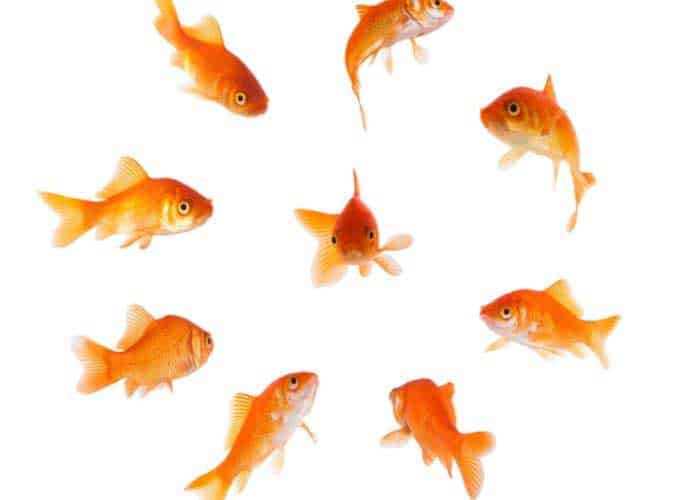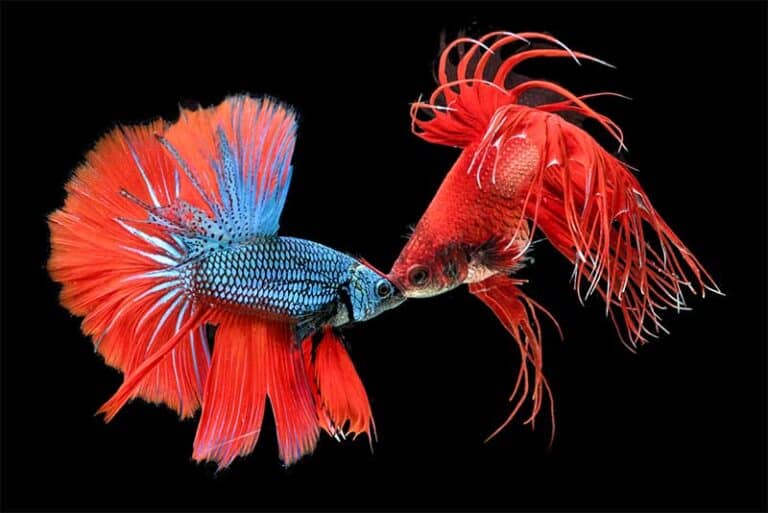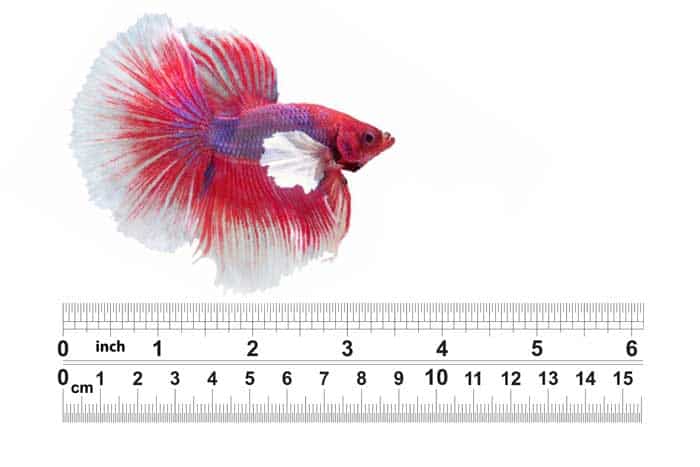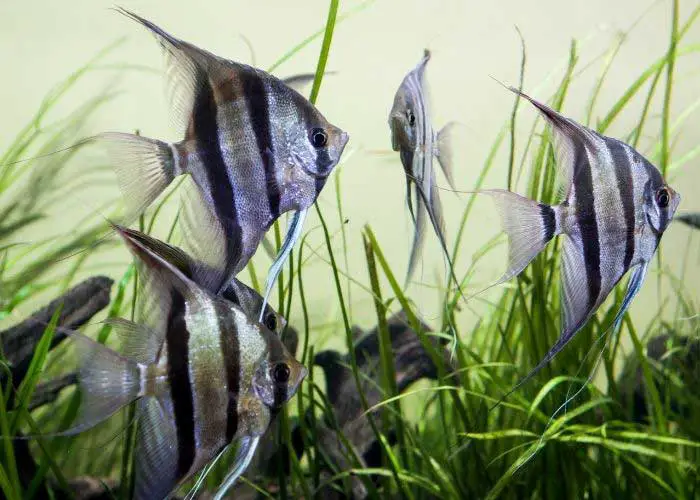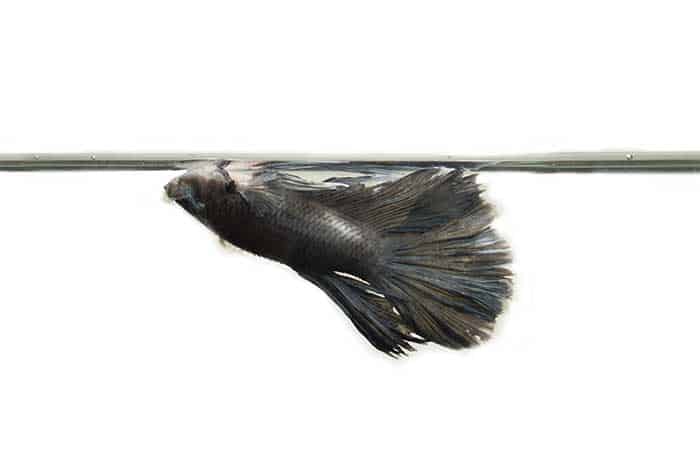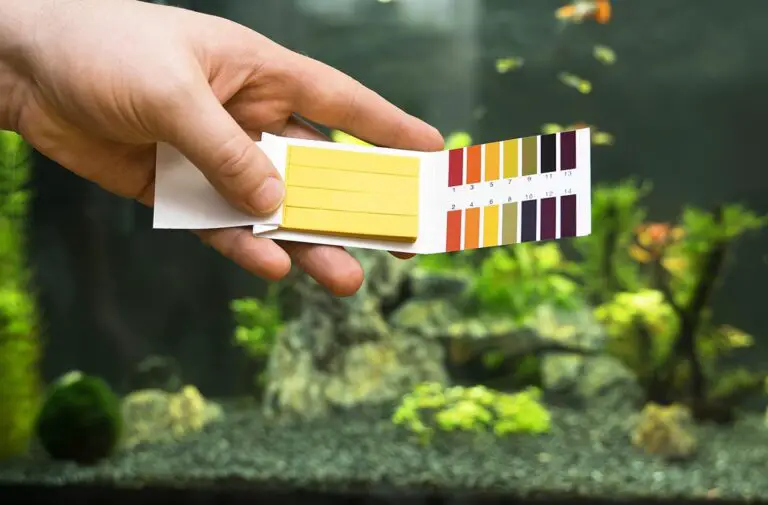Why Are My Fish Swimming At The Top Of The Tank (Top Causes)
There is one question I probably get asked more than any other: “Why are my fish swimming at the top of the tank?” Although this question is not always straightforward, there are some common reasons.
Some of the main reasons why fish swim at the top of the tank are:
- Your fish are expecting to be fed.
- Lack of oxygen (Hypoxia)
- Swim Bladder Disorder
- Naturally Upper-Level Fish
- You have labyrinth fish (Air-breathing fish)
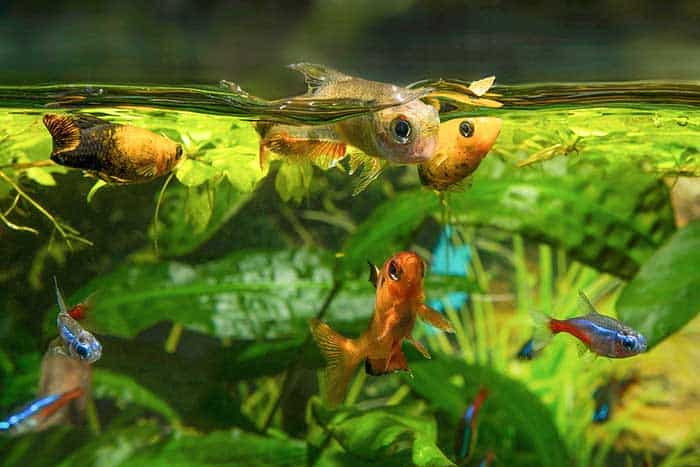
Let’s take a brief look at each of these in more detail.
Feeding Time
Fish are pretty good at knowing when it’s feeding time. If you always feed your fish at the same time each day, they will start to associate that time with food and begin to swim around more vigorously, heading toward the top of the tank in anticipation.
If you think this might be why your fish are swimming at the top of the tank, try feeding them a little earlier or later than usual and see if their behavior changes.
Lack Of Oxygen (Hypoxia)
If your fish are swimming at the top of the tank and gasping for air, it’s likely they are not getting enough oxygen. The oxygen that fish breathe enters the water at the surface through the gas exchange process.
Any disturbance to the surface water will allow oxygen to enter and saturate the water, which becomes known as dissolved oxygen (DO).
The amount of DO in the water is an essential factor in the health of your fish, and too little can cause them to suffocate.
There are several reasons why the level of dissolved oxygen in your tank might be low:
- Not enough surface area for gas exchange.
- Poor water quality.
- Poor water circulation.
- Overcrowding.
If you suspect that lack of oxygen might be why your fish are swimming at the top of the tank, check the water quality and dissolved oxygen levels. You can do this with a simple test kit available from your local pet store.
I have an article all about how to oxygenate a fish tank which will also explain how to test oxygen levels.
Swim Bladder Disorder
Most fish have a swim bladder, an organ not much different from a bag that can fill with air. Fish can make minute adjustments to how much air is in their swim bladder, which dictates whether they float, sink, or remain static in the tank.
Swim bladder disorder is a malfunction of the swim bladder, which causes fish to lose control of their swimming ability. Although commonly known as swim bladder disease, it’s a symptom of an underlying illness.
Symptoms of swim bladder disorder include:
- Fish swimming upside down.
- Fish floating at the surface.
- Fish sinking to the bottom of the tank.
One of the common causes of swim bladder disorder is constipation, where the fish’s bowel becomes obstructed, causing bloat, which blocks the inflation or deflation of the swim bladder.
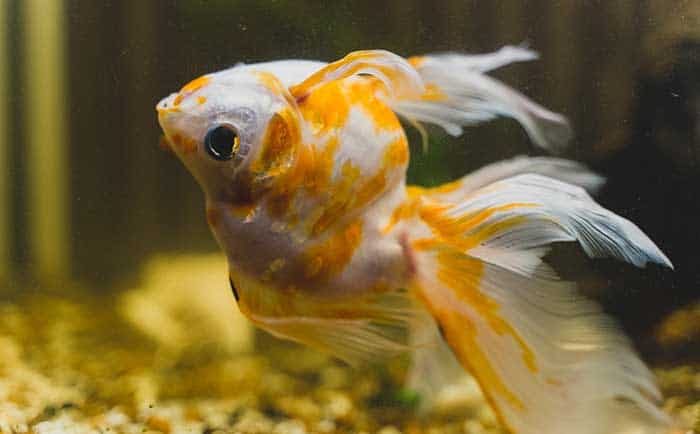
A swim bladder that won’t deflate can cause a fish to remain at the surface, unable to sink. If the swim bladder is inflated but not functioning correctly, it can also cause a fish to flip over and swim upside down.
If you think your fish might have swim bladder disorder, take them to your local vet or aquarium store for a diagnosis.
Naturally Upper-Level Fish
Some fish are naturally upper-level swimmers and will spend most of their time near the surface. This is perfectly normal behavior and nothing to be concerned about.
If you have a mixed aquarium with fish of different species, it’s pretty common to have fish that remain near the surface, while other fish will stay at a mid-level and some at the lower level.
You Have Labyrinth Fish (Air-breathing fish)
If you have labyrinth fish, they will often swim at the top of the tank, where they can gulp air from the surface. This is perfectly normal for these types of fish.
The most common type of labyrinth fish are anabantids, which include betta fish, gourami, paradise fish, and dwarf gourami. Other common labyrinth fish include the walking catfish and loaches.
These types of fish have a unique respiratory system made up of a labyrinth organ that acts as a lung and allows them to breathe air directly from the surface. The labyrinth organ enables these fish to survive in environments where the water is low in oxygen.
If you have labyrinth fish, make sure the tank is covered, as they are often good jumpers and can easily escape from an open aquarium.
I found the below video on Youtube, which talks about the causes of fish swimming at the top of the tank.
Fish Swimming At The Top Of Tank And Dying
If your fish are swimming at the top of the tank and dying, they are either sick and unable to draw enough oxygen due to their condition, or there is simply not enough oxygen in the tank. A few reasons for low oxygen levels are a tank that is too warm, too many fish in the tank, and poor water quality.
A sick fish can suffer organ failure or damage to its gills, impairing its ability to absorb oxygen, which is also true of a fish dying of old age. A swim bladder disorder due to a more severe illness can also cause fish to float at the surface and die.
Fish typically head up to the tank’s surface because that is where the oxygen-rich water is. Oxygen enters at the water’s surface, so it makes sense that this is where fish will find the highest concentration of dissolved oxygen.
You will need to check your water quality and dissolved oxygen levels if you think the problem might be a lack of oxygen in the tank. If the levels are low, you will need to take steps to increase them.
There are several ways to add oxygen to a fish tank, such as:
- Adding an air pump or air stones. An air stone can create a beautiful column of air bubbles, causing agitation at the top of the aquarium, where the air bubbles burst and dissolve into the water.
- Using a water pump to create water movement and surface agitation.
- Raising your filter to create more surface water agitation.
- Over the long term, adding live plants increases dissolved oxygen levels in your fish tank water.
- If you have an overstocked aquarium, it will constantly lower the oxygen level, so you should consider removing some fish.
If the oxygen level in your aquarium is low, it is vital to take action quickly to save your fish.
If oxygen levels are normal after testing, you should seek advice to identify possible illnesses in any remaining fish before more fatalities occur. Any fish showing unusual behavior or symptoms of illness should be quarantined.
Most illnesses are treatable if a diagnosis is made early enough, so you should not ignore symptoms such as staying at the surface.
Fish At Top Of Tank Gasping
A common sign that there is not enough oxygen in your fish tank is when you find your fish at the top of the tank gasping for air. If you have several fish, but only one behaves this way, it is more likely due to illness.
If you have a fish gasping for air at the top of the tank, two things are going on. Firstly, fish struggling to breathe will head for the oxygen-rich surface water, and secondly, your fish will appear to gasp as it pulls extra water over the gills.
What Does A Fish Gasping For Air Look Like?
It is pretty easy to tell when fish are gasping for air as they will often open and close their mouths rapidly as if they are trying to take a breath, and the fish’s gills will be working much harder than usual, opening wider and for longer.
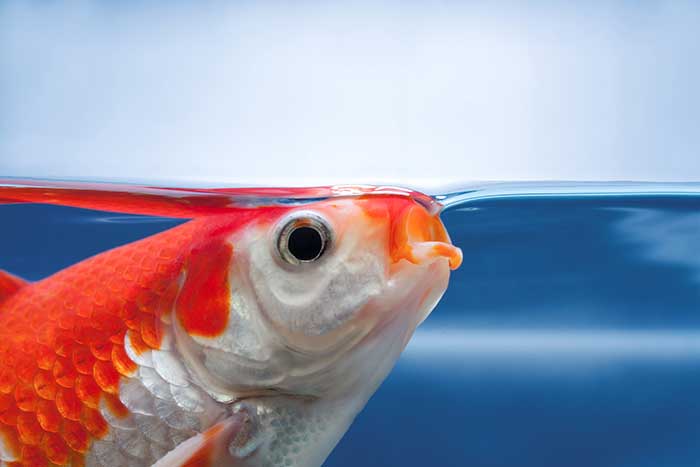
When fish gasp for air they are also likely to swim erratically, and you may see them flipping over on their side or floating at the surface. If your fish displays any of these symptoms, it is essential to identify the cause quickly and take action.
A fish at the top of the tank gasping for air is a sure sign that something is wrong, and you will need to check your water quality and dissolved oxygen levels immediately. If you have an air pump or bubbler, turn it on to help increase oxygen levels in the water.
Why Are My Fish Swimming At The Top Of The Tank After Water Change?
When done incorrectly, water changes can cause several problems that may cause your fish to swim at the top of the tank.
Sudden changes in water temperature can cause shock to fish, so they may seek cooler water at the surface, or if your fish tank has become cloudy from an algae bloom, fish may head to the top of the tank in search of fresher water.
To avoid causing shock to your fish when changing the water, you need to make it similar to the old water, especially in temperature, hardness, and pH levels. Matching water parameters is more challenging with large water changes, whereas more minor changes will quickly dilute when added to the tank.
A large water change can also remove much of the necessary beneficial bacteria when done wrong, and this can cause ammonia levels to spike. If this is the case, you will need to know how to cycle a fish tank or how to emergency cycle a fish tank.
Always make sure you know what water to use for betta fish and the best parameters to aim for before adding any new water to your tank.
New Fish Swimming At Top Of Tank
Before adding new fish to your tank, they will need to be adequately acclimated; otherwise, they may experience shock due to the sudden change in water parameters.
As described above, temperature shock or pH shock can stress your sensitive fish, so they will often swim at the top of the tank until they adjust.
When you purchase new fish, they are usually transported in a bag or container of original tank water, but it’s unlikely the water in their new tank will match. Acclimating fish allows them to adapt gently to their new environment and water conditions.
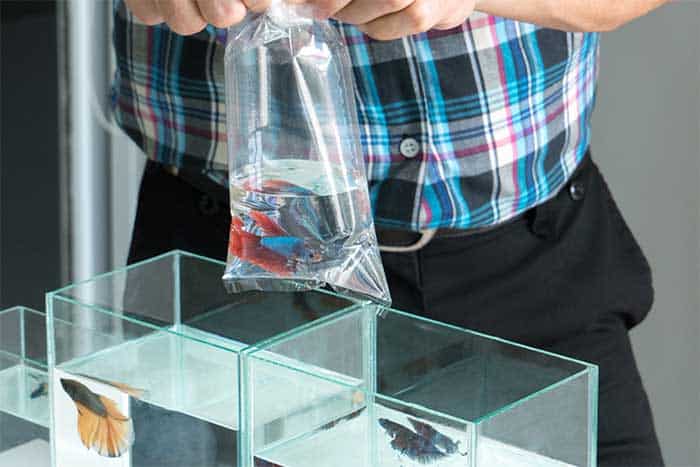
The best way to acclimate your new fish is to float their bag in your fish tank for around 30 minutes. This will allow the water in their bag to match the water temperature in your tank.
After 30 minutes, you can add a cup of your aquarium water to their bag, wait another 15 minutes, and repeat this process until their bag is full. You can then release your new fish into the tank.
Swimming at the top of the tank can signify something is wrong with your fish, but it can also be caused by a lack of acclimation or water changes. If you notice any other symptoms, such as lethargy, listlessness, or abnormal behavior, check your water quality and take action.
Fish Swimming At Top Of Tank At Night
Another common behavior is fish swimming at the top of the tank at night. You may find this behavior if you have a well-planted tank.
Plants produce oxygen during the day while absorbing carbon dioxide. At night, plants will absorb oxygen. If you have an overstocked tank, plants will compete with your fish for oxygen at night, causing your fish to swim to the top of the tank, where oxygen is more abundant.
Although this is one common reason why your fish may swim at the top of the tank at night, there could also be several other reasons which may not be related to a lack of dissolved oxygen.
Fish may prefer sleeping at the top of the fish tank at night because the current is weaker, or they may feel less threatened. These are all behavioral, and you should not worry.
If you find your fish swimming at the top of the tank at night, you need to check that oxygen levels have not dropped, and if they have, use other methods to introduce a surplus of oxygen to support both plants and fish during the night.
Fish At Top Of Tank But Not Gasping
Several possible explanations exist if your fish are hanging out at the top of the tank but not gasping for air.
Firstly, if water quality is poor, ammonia and nitrites are present, or there are other chemicals in the water, fish will often retreat to the surface where water may be cleaner and there is a higher oxygen concentration. You should always check your water parameters when fish behave differently than usual.
Secondly, the water temperature may be too warm or cold, and the surface may be more comfortable. Check the temperature in several areas of the tank. If you find warm or cold spots that your fish are avoiding, relocate your heater to heat the tank evenly.
Third, your fish may be bored or stressed. If they are not getting enough exercise, they may become restless and swim at the top of the tank. Provide hiding places, plenty of plants, and toys for them to play with to help reduce stress levels. You may also need to rearrange your aquarium decorations to provide a more stimulating environment.
Finally, some fish simply prefer to spend time at the top of the tank. Observe your fish from a distance, and if they seem healthy and happy, there should be no need to worry. It is easy to mistake normal behavior for something else, especially when some fish varieties and species can display very bizarre behavior.
Fish Staying At Top Of Tank – What To Do
If you are concerned about your fish staying at the surface, below you will find my “fish staying at top of tank checklist.” Although there are many reasons why fish will remain at the surface, it can be a sign that something is wrong.
Fish Staying At Top Of Tank (Checklist)
- Check oxygen levels with a meter. Lack of oxygen can cause fatalities and should be rectified as soon as possible. Consider removing some fish or adding an air pump.
- Check water parameters with test strips. If you have high ammonia levels, nitrites, chlorine, etc., you will need to perform a large water change and replace the water with clean treated water of a similar temperature. Sudden changes to your water parameters can cause stress and illness. Read this article for more information: How To Lower Ammonia In Aquarium.
- Check the water temperature throughout the tank. If your water temperature is inconsistent throughout the tank, move your heater closer to the filter, or consider using a second heater. A weak filter may not transfer the heat evenly, or there may be a prominent heat source near the surface that your fish prefer. Also, if your aquarium heater is set too high, warm water holds less oxygen, so you need to reduce the temperature.
- Check your fish are not hungry. If your fish are waiting to be fed, make sure they get enough food throughout the day. Introduce a second feed if necessary, but monitor waste levels to ensure it doesn’t rot and cause problems with ammonia.
- Observe your fish for signs of illness. If your fish show symptoms of illness such as swim bladder disease, parasites, or bacterial infection, they need to be treated. You should seek advice from a professional to establish a suitable treatment. Illness is often easier to establish when only one or two fish behave oddly and stay at the top of the tank.
Don’t be alarmed if you find your fish swimming at the top of the tank. It is perfectly normal behavior and nothing to worry about in most cases. However, if you are concerned, use this checklist to investigate the cause and take appropriate action. With care and attention, you can ensure your fish remain healthy and happy.
Final Thoughts
So as you can see, the question, “Why are my fish swimming at the top of the tank?” is not so straightforward. There can be several reasons why your fish are swimming at the top of the tank, so It’s essential to investigate and correct any potential problems.
On some occasions, swimming at the surface is perfectly natural, but on other occasions, it can signify that something is wrong with your fish or their environment. By following our checklist and observing your fish for signs of illness, you can ensure their health and happiness.


